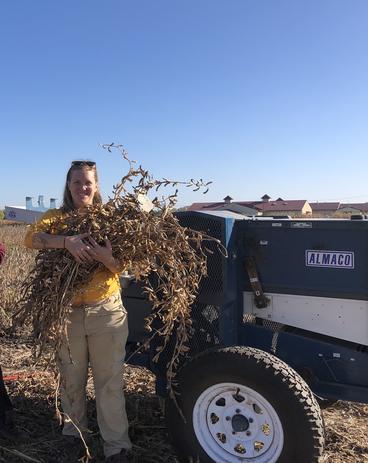Alisha Hershman is an MSc student in her second year in Megan McCaghey’s lab.
Alisha grew up in Sioux Falls, South Dakota and had early exposure to the impacts of plant pathology through observing diseased plants while gardening with her mother as well as seeing the devastation from mountain pine beetles in the Black Hills. While the pull of working with beautiful flowers in public gardens was a motivator when she started her undergraduate education, she soon found herself intrigued with plant pathology (through an Introduction to Plant Path course she took) and the monumental impact that learning about Norman Borlaug had on her life’s goals. There was a sudden shift from yearning for pretty flowers to wanting to help feed the world. She went on to complete her Bachelor of Science degree in 2015 in Horticulture with an emphasis on plant breeding and genetics.
After graduating, she worked seasonally at the Morton Arboretum in Lisle, IL before landing a full-time job at Cibus (formerly Calyxt) and stayed on for 5 years. She spent her days doing tissue culture, protoplasting cells, and working on various consumer projects like developing high oleic/low linolenic soybean lines along with developing and optimizing tissue culture in canola, alfalfa, and hemp crops. Despite enjoying her time at Cibus, her interest in plant pathology grew and she knew she didn’t have the needed background to do the work she really longed to do. She applied to the University of Minnesota for a MSc program to deepen her knowledge base.
She joined the lab of Megan McCaghey in the fall of 2022 to work on a Sclerotinia project. Sclerotinia stem rot, also known as white mold, is a major yield limiting soybean disease. This pathogen is very sensitive to the growing environment, resulting in widely variable infection rates from year to year and site to site. The fungus that causes white mold overwinters in the soil as sclerotia, which are melanized structures that look a bit like mouse droppings. These sclerotia, given the ideal cool and moist conditions, can germinate and produce apothecia, which are small-spore producing mushroom-like structures. When spores are released from the apothecia, they drift upwards and land on senescing soybean flowers, feeding off the nutrients and germinating, finally spreading into the stem at the node. To induce a substantial infection capable of causing yield loss, ideal conditions are needed for every step of the cycle and a susceptible soybean variety must be the host. While this makes for a complicated pathogen to study, it also means that there are many potential ways to interrupt the progression.
Alisha is working on a joint project with Aaron Lorenz’ lab, looking at plant architecture and how the shape and size of plants, as well as their susceptibility and environmental conditions all combine to give Sclerotinia a leg up. Because Sclerotinia needs shade, moisture, and cool temps to develop spores, looking at how densely grown the upper canopy is in any soybean line can give clues to necessary conditions for the devastating infection.
In addition to her research, Alisha has participated in the Borlaug Memorial lecture planning committee for the last 2 years. It has been an honor for her to be able to help with this event as learning about Borlaug’s work has had such a large impact on her life. A particular highlight was attending the World food prize conference known as the “Borlaug Dialogue” which is a 3-day conference that gathers experts in development, agriculture, economic policy, resource management and nutrition.
As for what she hopes to do following her work here at the U, she isn’t set on anything yet. She has found that she loves hands-on research as well as farmer outreach events and presenting her work to interested parties. Because of this mix of interests, Extension work is an item on her list of possible next steps, but for now she is really enjoying digging into her project, training undergrads, and learning as much about plant pathology as possible, starting the new year off with an Ecology, Epidemiology, and Evolutionary Biology of Plant-Microbe Interactions course taught by her Advisor, Megan McCaghey.
